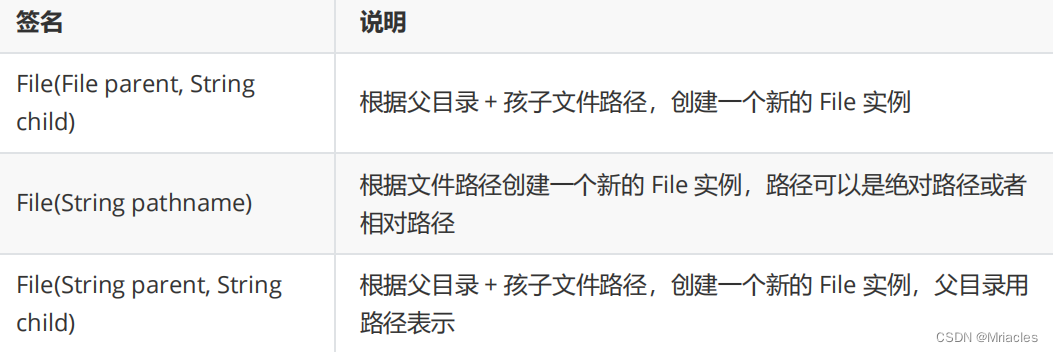前言认识文件
狭义上的文件(file)。针对硬盘这种持久化存储的I/O设备,当我们想要进行数据保存时,往往不是保存成一个整体,而是独立成一个个的单位进行保存,这个独立的单位就被抽象成文件的概念,文件由文件夹以及目录来管理;
绝对路径与相对路径
绝对路径: 是固定的,是不变的,唯一路径
相对路径 : 是根据你当前所在的节点所往后推导的路径
普通文件与二进制文件
普通文件: 用记事本打开能看
二进制文件: 用记事本打开看不了
也可以看下面字符集的编码格式
Java中的操作文件
File 类
构造方法

public static void main(String[] args) throws IOException {
File file = new File("..\\hello-world.txt"); // 并不要求该文件真实存在
// 得到父目录文件的路径
System.out.println(file.getParent());
// 得到文件名字
System.out.println(file.getName());
// 得到文件路径
System.out.println(file.getPath());
// 得到文件绝对路径
System.out.println(file.getAbsolutePath());
// 得到文件相对路径
System.out.println(file.getCanonicalPath());
// 判断文件是否存在
System.out.println(file.exists());
// 判断文件是否是目录
System.out.println(file.isDirectory());
// 判断是不是一个普通文件
System.out.println(file.isFile());
// 创建一个新的文件
System.out.println(file.createNewFile());
//删除一个文件
System.out.println(file.delete());
//创建目录
System.out.println(dir.mkdir());
//文件重命名
System.out.println(file.renameTo(dest));
}
文件的读写
InputStream
int read() 读取一个字节的数据,返回 -1 代表已经完全读完了
int read(byte[] b) 最多读取 b.length 字节的数据到 b 中,返回实际读到的数量;-1 代表以及读完了
int read(byte[] b,int off, int len)最多读取 len - off 字节的数据到 b 中,放在从 off 开始,返回实际读到的数量;-1 代表以及读完了
void close() 关闭字节流
InputStream 只是一个抽象类,要使用还需要具体的实现类。
try (InputStream is = new FileInputStream("hello.txt")) {
while (true) {
int b = is.read();
if (b == -1) {
// 代表文件已经全部读完
break;
}
System.out.printf("%c", b);
}
}
public static void main(String[] args) throws IOException {
//文件内容中填充中文
try (InputStream is = new FileInputStream("hello.txt")) {
byte[] buf = new byte[1024];
int len;
while (true) {
len = is.read(buf);
if (len == -1) {
// 代表文件已经全部读完
break;
}
// 每次使用 3 字节进行 utf-8 解码,得到中文字符
// 利用 String 中的构造方法完成
// 这个方法了解下即可,不是通用的解决办法
for (int i = 0; i < len; i += 3) {
String s = new String(buf, i, 3, "UTF-8");
System.out.printf("%s", s);
}
}
}
}
对字符类型直接使用 InputStream 进行读取是非常麻烦且困难的,所以,我们使用一种我们之前比较熟悉的类来完成该工作,就是 Scanner 类。
try (InputStream is = new FileInputStream("hello.txt")) {
try (Scanner scanner = new Scanner(is, "UTF-8")) {
while (scanner.hasNext()) {
String s = scanner.next();
System.out.print(s);
}
}
}
OutputStream
void write(int b) 写入要给字节的数据
void write(byte[] b)将 b 这个字符数组中的数据全部写入 os 中
int write(byte[]b, int off,int len)将 b 这个字符数组中从 off 开始的数据写入 os 中,一共写 len 个
void close() 关闭字节流
void flush() 重要:我们知道 I/O 的速度是很慢的,所以,大多的 OutputStream 为
了减少设备操作的次数,在写数据的时候都会将数据先暂时写入内存的
一个指定区域里,直到该区域满了或者其他指定条件时才真正将数据写
入设备中,这个区域一般称为缓冲区。但造成一个结果,就是我们写的
数据,很可能会遗留一部分在缓冲区中。需要在最后或者合适的位置,
调用 flush(刷新)操作,将数据刷到设备中。
try (OutputStream os = new FileOutputStream("output.txt")) {
// 字符写入
os.write('H');
os.write('e');
os.write('l');
os.write('l');
os.write('o');
// 不要忘记 flush
os.flush();
}
try (OutputStream os = new FileOutputStream("output.txt")) {
String s = "Nothing";
byte[] b = s.getBytes();
os.write(b);
// 不要忘记 flush
os.flush();
}
try (OutputStream os = new FileOutputStream("output.txt")) {
String s = "你好中国";
byte[] b = s.getBytes("utf-8");
os.write(b);
// 不要忘记 flush
os.flush();
}